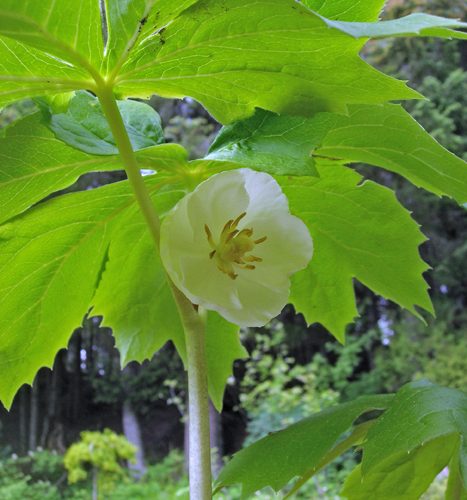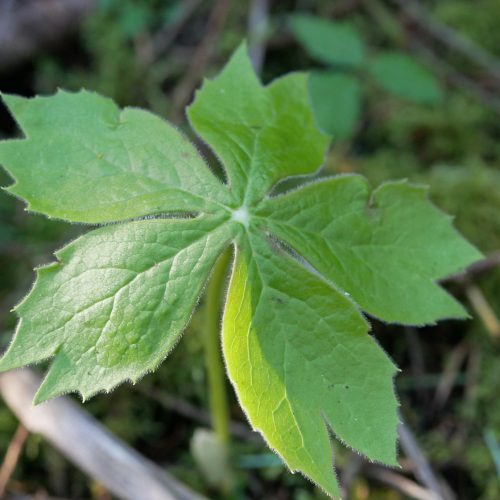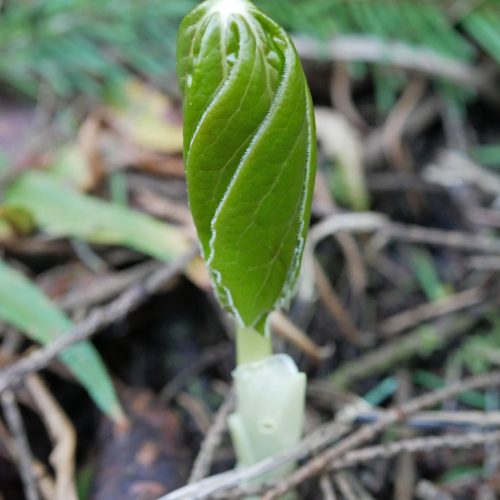By Will Clausen, Gardener at the RSBG
Pushing through the layer of accumulated forest duff, leaves folded into pleated spirals with fine hair fringing their margins, the emerging mayapple (Podophyllum peltatum) is a reassuring sign of spring. Growth progresses quickly as temperatures warm and days lengthen. The leaves unfurl and expand, gathering steam and becoming deeply lobed, umbrella-like photosynthesizing machines measuring up to a foot or more across. The stalk is attached to the underside of the leaf at the middle rather than along the edge, making these leaves peltate. Mayapple are rhizomatous woodland plants, spreading underground and forming large colonies. In the densest areas of an established colony, mature leaves overlap and completely obscure the ground below.
Mayapple exhibits two distinct aboveground growth forms. Arising from the shallowly buried rhizome and growing to about one foot high, some stalks hold a single leaf. From other buds, stalks holding two leaves will emerge. These two-leaved stalks are forked at about ¾ of their height, with each fork holding a leaf at its end. At the fork of these stalks, below the two leaves, a flower is found. When the stalk first emerges, the flower bud is visible from above, crammed between the two folded leaves. As time goes on, the leaves overtake the flower bud which will remain hidden below them as it develops and opens.
The single flower, 1-2 inches across, is held on relatively short pedicle. It’s overlapping petals are white, though in certain light I think they can sometimes take on a hint of green. The cream-yellow stamens and ovary make a nice color combination with the petals and the flowers are just generally lovely. Because they grow from spreading rhizomes, mayapple are not reliant on flower pollination and seed set to thrive in localized spots. They spend more energy expanding below ground than they do on producing seed. But ultimately plants must occasionally reproduce sexually, and when flowers of one mayapple are pollinated by passing bees that have visited another nearby mayapple colony, a round fruit will form. Roughly the size of an egg and yellow-green, this is the “apple” for which the plant is named. The ripe flesh of a mayapple fruit is the only part of the plant that can’t kill the consumer. Though it is apparently safe in small doses and tasty, I have never tried it myself and will probably steer clear just in case. It’s good enough to just look at. Concealed beneath the domineering leaves, getting a good look at the flower and fruit usually requires some work from the human viewer. But just as it is for so many beautiful but small plants, it’s well worth the effort and a bit of dirt on your knees.
Mayapple can be found in the wild in damp woodland throughout much of the eastern United States. Like many other eastern woodland plants (including rhododendrons), it has the curious quality of being most very closely related to plants from east Asia, though there is no physical connection in between. The link between the flora of eastern North America and east Asia shows that these two distant regions have been geographically and/or ecologically connected in the past and that the ancestors of their now disjunct floral elements were once intermingled. Just some more evidence of the mind-boggling age of this planet. Podophyllum peltatum is the one accepted North American species, while in Asia there are at least a handful of others. The taxonomy is unsettled, with some including the Asian mayapples in Podophyllum and others placing them in unique genera (Dysosma, Sinopodophyllum). Regardless they are certainly very closely related, and the unique mayapple characteristics are strikingly similar between them all.
Mayapple makes a great garden plant given a good amount of shade and moist, organic-rich soil along with room to spread. It can even take a blasting from the sun as long as the soil never dries out. Make sure to get at least two different clones if you want fruit. The Asian species and cultivars are particularly popular among gardeners, relatively new, and thus often remarkably expensive. The leaf patterns and coloration on these plants can be awesome and weird, but for me P. peltatum, plain and simple by comparison, can’t be beat. At the RSBG, you will find healthy colonies of mayapple carpeting part of the forest floor in the Big-leaf Rhododendron Garden.



